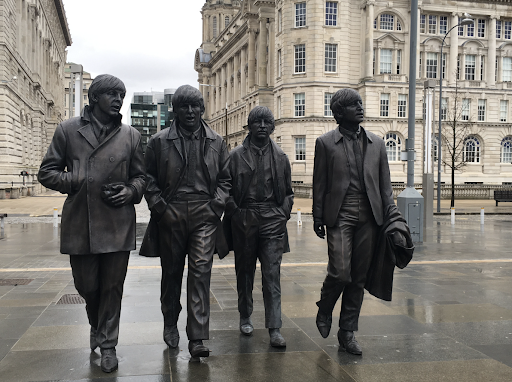
Then and Now: AI’s Role in The Beatles’ Hidden Gem
Just when we thought The Beatles’ songbook was complete, along came 2023’s AI revolution, gifting us “Then and Now.” It’s a fresh Beatles tune for vinyl lovers and streamers alike, offering a sound that’s crystal clear and new.
Join us in exploring the technological process that led producer Giles Martin to transform an old lo-fi recording into a chart-topping number with the help of advanced AI and Machine Learning tools.
Background to “Then and Now”
Less than two years ago, Giles Martin, son of the original Beatles producer George Martin, stated it would be impossible to remix The Beatles’ pre-1967 work due to technological barriers. Martin indicated that a drastic advancement in audio technology would be necessary.
What was the main challenge in making a refreshed version of the amazing earlier records from the Liverpool band?
The Problem with Master Tapes
The biggest problem lay in the quality and availability of the master tapes. Starting with “Sgt. Pepper” in 1967, The Beatles recorded most of their instruments and vocals on separate tracks. For Martin, boosting the volume of the voice or an instrument in these later releases was relatively simple. However, on earlier albums, the band often combined multiple sounds onto the same track making it difficult for future remixers to adjust them individually.
Furthermore, the band and producers never imagined that people would listen to their songs through earbuds. Their early albums’ stereo versions were mixed with extreme separation between the right and left channels, resulting in a skewed balance.
Second, record labels keep master tapes (especially relics like The Beatles’) in safekeeping, and they are not easily accessible. As a result, producers must work with public versions, some of which are of higher and others of lower quality.
Peter Jackson Changes the Game
The famous filmmaker Peter Jackson brought AI into the mix, and intentionally or unintentionally helped solve the problem that restricted Giles Martin. Jackson was hired to create a TV series about the material from the 1970 Beatles documentary “Let It Be”. According to Vulture, much of this content was previously considered unusable because the band’s conversations were overwhelmed by their instruments on the mono audio tapes. Then, Jackson’s engineering teams developed their own machine-learning “de-mixing” software that could isolate intertwined sounds. Martin speculated whether Jackson’s software might also isolate sounds on The Beatles’ early studio albums. This led to the remixed version of “Revolver”, launched in 2022.
And now, on November 2, 2023, we were presented with a new Beatles song, created with the invaluable collaboration of AI tools.
AI Recovering the Essence of Artists
AI can dissect and reconstruct the layers of sound, as seen with The Beatles’ archival projects, allowing musicians and producers to interact with their art in ways that were previously limited by technological barriers.
Moreover, this collaboration opens the door to reimagining the creative process itself. Artists can now delegate technical tasks to AI, allowing them to focus on the essence of their artistic creations. As a result, AI is the tool that guides human capabilities into a universe of infinite possibilities, strengthening rather than replacing artistic expression.
Will It Pass the Test of Sound Purists?
AI can do much more than separate sounds. It can go into the very essence of what distinguishes an artist’s or band’s sound. By analyzing the timbre, pitch, and intensity of The Beatles’ voices, as well as the distinct sound of their instruments, AI algorithms can now restore or even recreate lost or damaged elements of music. This technological prowess does more than just filter out noise; it reconstructs history.
Through learning and mimicking the acoustic signatures of John, Paul, George, and Ringo’s voices, as well as the characteristic twang of a Rickenbacker or the warmth of a Hofner bass, AI can help fill in the blanks on the tapes.
The Technical Capabilities Behind the Music
The technology enabling the new Beatles song is iZotope RX, a cutting-edge AI and ML tool that meticulously dissected the old recordings. It isolated instruments and vocals that were previously inseparable, enabling producers to reconstruct the sound with a clarity and balance never thought possible.
In essence, AI can now act as an audio archaeologist.
Human-AI Collaboration: The Power Duo
As we look toward the horizon of music production, the AI-driven tools at our disposal are more than just utilities; they represent the incredible power of collaboration between human creativity and artificial intelligence. InclusionCloud AI trends report for 2024 highlights this synergy, particularly in creative industries where AI is not just an assistant but a partner in the creative process.
The trend points toward a future where AI collaborates with human artists, offering novel ways to enhance and express creativity. It’s a future where AI helps to navigate complex creative challenges, opening up a spectrum of possibilities that were once inconceivable.
Conclusion
In essence, these AI-driven audio tools assist users in achieving a professional sound by automating complex processes, enabling them to focus on the creative aspects of music production. They have become indispensable for anyone aiming to clean up recordings, enhance sound quality, and create a polished final product.
Giles Martin reflects on the fusion of tradition and innovation:
“What’s great about the opportunities that I get is that I can apply new technology that we’re inventing to an old catalog that deserves it, and that has a tradition of breaking new ground and breaking new boundaries.“
His words underscore a profound truth: AI’s role in uncovering The Beatles’ “Then and Now” is a landmark example of how emerging technology can serve not just to preserve but to evolve a legendary musical legacy.







